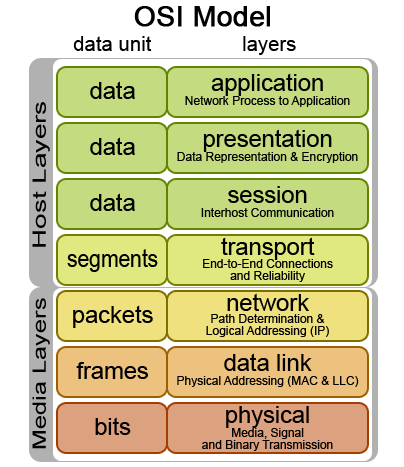Ceci est une ancienne révision du document !
Networks, Internet and Web Services, BAT4
Main Advisors : Ass. Prof. J.Y. Tigli, Ass. Prof. H. Collavizza
Language : English
Networks introduction
Lecturer : Ass. Prof. J.Y. Tigli
All the networks introduction is dedicated to explain what are the differents technology for Telecommunications and Data Communication Systems are used in Smart Buildings.
Generally these basic concepts are necessary to understand how to deploy electrical low power in future building.
All the explanations in the course are related to one common model shared by the most of electrical, electronical, control, computer and software engineers in this field : OSI Model

Session 1 : Networks introduction : OSI Physical / Data Layers
Lecturer : Ass. Prof. J.Y. Tigli
Course Material :
Purpose of the course :
- Telecommunication Principles : Medium and Analog Signal propagation
- Data Communication : Data encoding on Analog Signal
- Different Types of Medium and basic signal frequencies
- Different Types of Techniques for Data encoding on a medium and corresponding equipments
- Different Types of Techniques for Simultaneaous Data Communications on a medium and corresponding equipments
- Introduction to the OSI Model after the introduction to the two first layers
- Slides of the course : Networks Introduction for physical and data layers in OSI Model
Session 2 : Data Link Layer and Ethernet
Session 3 : Network Installation, Lab on a use Case
The purpose of this lab is to produce documents and planning studies for implementing local telecommunication networks (like Ethernet and wifi) and a dedicated electrical distribution for a three-levels building.
Networks Layout Floor Plan for the Exercice
- Installation for a try period of ConceptDraw Office
The plan of the building is here. Download it to add all information you want on it with your favorite graphical software (ConceptDraw for example).
The document giving all the information about the project is here.
Session 4 : Internet and its Transport protocols
Session 3 : UDP & TCP introduction, TCP C# .Net Programming
Session 4 : TCP/IP Web Server and Introduction to Web Services
TCP/IP Web Server
- Test it with your favorite web browser
Introduction to Web services through examples
My first software service over TCP/IP
- Modify the source code of the example of the session 3 to run the server and the client on different computers (be careful, sometimes firewall may block the ports for communications between computers)
- Modify the same code to implement server that receive two double values and return their addition to the client. THIS IS YOUR FIRST SOFTWARE SERVICE ! the Client subcontracts the add operation to the server.
My first software service over Web (i.e. Web Services)
* Web is when HTTP protocol is used over TCP/IP protocols for communications between a client and a server.
- Modify the Web server code above to implement server that receive two double values after the ? and & caracters in the URL (ex. http://localhost:8080/add?val1=3&val2=5) and return their addition to the client (ex. in our case : 8) THIS IS YOUR FIRST WEB SERVICE ! the Client subcontracts the add operation to the web server.
Why Web Services are interesting ?
- because the port 80 of the web servers is generally one of the few not to be filtered by the firewalls
- because all the major software companies are sharing web service standards and allow to program servers and clients using these common standards
- because thanks to some of these standards, using remote web service is very easy in a software client. For example, with WS-SOAP we import functionalities from Web Service in a software client like from DLL with add Web references to the client project instead of add References)
Accessing RESTful Web Services
REST stands for REpresentational State Transfer. REST is a web standards based architecture and uses HTTP Protocol for data communication (see for short introduction https://www.ibm.com/support/knowledgecenter/en/SSGMCP_5.2.0/com.ibm.cics.ts.webservices.doc/concepts/concepts_restful.html).
In this session, we concentrate on RESTful webservices that uses resources represented in json. You first learn how to handle json data and then how to connect and use data from a weather Web Service and a geographical Web Service.
- Introduction to json : C# solution with simple examples of json manipulation
- Accessing a weather and a geographical Web Service : C# solution to access openweather Web Service.

